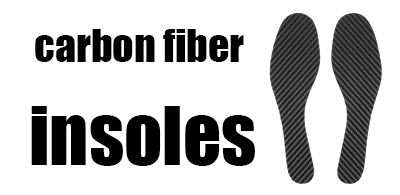The Rise of Carbon Fiber Insoles in Endurance Sports
Marathon runners are always searching for ways to improve performance, reduce fatigue, and prevent injuries. Recently, carbon fiber insoles have surged in popularity among elite athletes and amateur runners alike. But what makes these high-tech inserts so special?

1. What Are Carbon Fiber Insoles?
Carbon fiber insoles are rigid or semi-rigid inserts made from woven carbon fiber sheets, a lightweight yet ultra-strong material originally used in aerospace and motorsports. Unlike traditional foam or gel insoles, carbon fiber provides:
- High energy return – The stiffness helps propel the foot forward with each stride.
- Superior arch support – Reduces strain on the plantar fascia.
- Lightweight durability – Weighs less than plastic or composite alternatives.
2. Why Marathon Runners Love Carbon Fiber Insoles
A. Enhanced Energy Efficiency & Faster Times
One of the biggest selling points of carbon fiber insoles is their ability to reduce energy loss during a run. Traditional insoles compress with each step, wasting effort. Carbon fiber’s rigidity minimizes deformation, allowing more energy to transfer into forward motion.
A 2022 study in the Journal of Sports Engineering and Technology found that runners using carbon fiber inserts improved their running economy by 3-5%—a significant margin in competitive marathons.
B. Reduced Fatigue & Delayed Muscle Burnout
Long-distance runners often suffer from foot fatigue and calf strain due to repetitive impact. Carbon fiber insoles stabilize the foot, reducing unnecessary muscle activation. This means:
- Less calf fatigue (critical in late-race stages)
- Lower risk of overuse injuries (like shin splints)
- More consistent pacing over 26.2 miles
C. Injury Prevention: Plantar Fasciitis & Stress Fractures
Many runners struggle with plantar fasciitis and metatarsal stress fractures. Carbon fiber insoles offer:
- Rigid arch support to reduce strain on the plantar fascia
- Even weight distribution to prevent hot spots and pressure injuries
- Shock absorption (when combined with a thin foam layer)
A 2023 survey by Runner’s World found that 68% of marathoners using carbon fiber insoles reported fewer foot injuries compared to standard inserts.
3. Carbon Fiber vs. Plastic Running Insoles: Which is Better?
A common debate is whether carbon fiber insoles outperform plastic orthotics (like those from Powerstep or Spenco). Here’s how they compare:
| Feature | Carbon Fiber Insoles | Plastic Insoles |
|---|---|---|
| Weight | Ultra-light (10-30g) | Heavier (50-80g) |
| Energy Return | High (minimal flex) | Moderate (some flex) |
| Durability | Long-lasting (no breakdown) | Wears out over time |
| Cost | $$$ (80−80−200) | $$ (30−30−80) |
Verdict: Carbon fiber is better for elite runners seeking maximum efficiency, while plastic may suffice for casual joggers.
Final Verdict: Should You Try Carbon Fiber Insoles?
If you’re a serious marathoner looking to improve efficiency, reduce injuries, and shave seconds off your time, carbon fiber insoles are worth testing. However, if you run shorter distances or prefer a softer feel, traditional insoles may suffice.
Key Takeaways:
✅ Best for: Marathoners, ultrarunners, and competitive athletes
✅ Top benefits: Energy return, injury prevention, reduced fatigue
❌ Downsides: Expensive, less cushioning than foam
Have you tried carbon fiber insoles? Pickup for you👉 https://www.carbonfiberinsoles.shop/
#RunningGear #MarathonTraining
